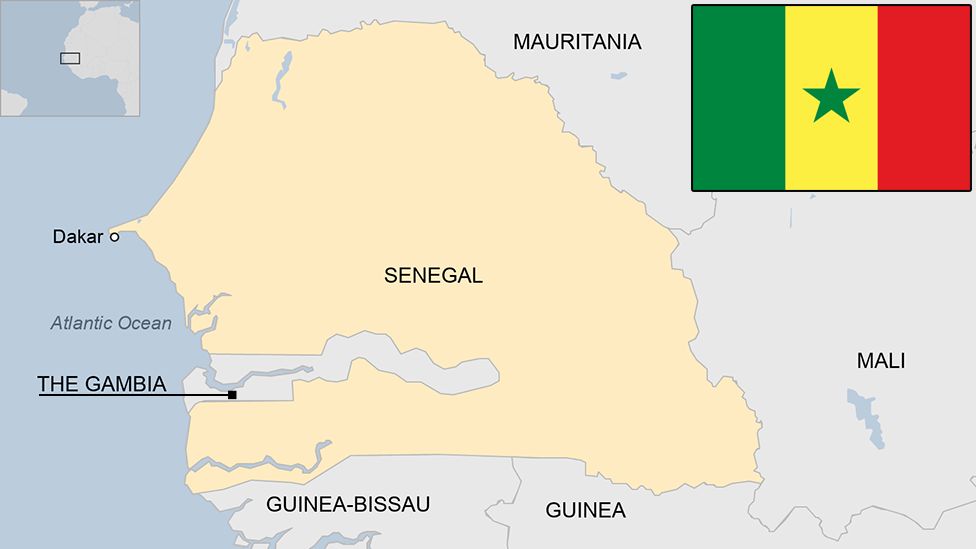Senegal country profile
- Published

Long considered one of Africa's model democracies, the west African nation of Senegal has a tradition of stable governments and civilian rule.
Slaves, ivory and gold were exported from the coast during the 17th and 18th Centuries, and now the economy is based on agriculture. The money sent home by Senegalese living abroad is a key source of revenue.
Hundreds of Senegalese were killed in a separatist conflict in the southern region of Casamance, but violence lessened after a 2014 ceasefire. The country's stability has allowed it to send peacekeeping troops to DR Congo, Liberia and Kosovo.
In February 2024, President Macky Sall plunging the country into a crisis when he postponed presidential elections, amid what some saw as a threat to one of the remaining democracies in coup-hit West Africa.
However, an election was held in March 2024 with opposition politician Bassirou Diomaye Faye winning the poll to become Africa's youngest elected president.
- Read more country profiles - Profiles by BBC Monitoring
REPUBLIC OF SENEGAL: FACTS
- Capital: Dakar
- Area: 196,712 sq km
- Population: 17.1 million
- Language: French
- Life expectancy: 65 years (men) 70 years (women)
LEADER
President: Bassirou Diomaye Faye
Bassirou Diomaye Faye's extraordinary rise to the presidency capped a rollercoaster period in Senegalese politics that caught many off-guard.
Months in jail alongside ally and kingmaker Ousmane Sonko ended suddenly, with the pair released just before the election.
The poll had been initially postponed by outgoing President Macky Sall who said the delay was necessary because disputes threatened the credibility of the vote.
But after a month of confusion and violent protests, the election was held in March 2024.
Faye won the first round with 54.28 % against 35% garnered by his main rival, ruling party candidate Amadou Ba.
Fighting poverty, injustice and corruption are top of his agenda. While working at the Treasury, he and Sonko created a union taskforce to tackle graft.
Gas, oil, fishing and defence deals must all be renegotiated to better serve the Senegalese people, Faye has said.
He has said he is ushering in an era of "sovereignty" and "rupture" as opposed to more of the same, and that is especially true of ties to France.
President Faye has said he will drop the much-criticised CFA franc currency, which is pegged to the euro and backed by former colonial power France.
He wants to replace it with a new Senegalese or regional West African currency, although this will not be easy.
MEDIA
Senegal has traditionally had one of the most unrestricted and diverse media scenes in the region."Solid democracy and laws guarantee press freedom" and violence against journalists is relatively infrequent, says Reporters Without Borders (RSF). However, there was a surge in verbal and physical violence against media outlets in 2021 after the arrest and release of opposition leader Ousmane Sonko.
TIMELINE
Some key dates in Senegal's history:
8th Century - Present-day Senegal is part of the Kingdom of Ghana.
11th Century - Islam comes to the region through contact with the Morocco-based Almoravid dynasty.
12th-14rth Centuries - Rise of the Jolof empire.
1440s - Portuguese traders reach Senegal river estuary.
1588 - Dutch establish slave port on island of Goree.
1659 - Fench found St-Louis at the mouth of the Senegal river; it becomes a key slave-trading port.
1677 - French take over island of Goree from the Dutch, the start of nearly 300 years of French oversight.
1756-63 - Seven Years War: Britain takes over French posts in Senegal, forms colony of Senegambia.
1775-83 - France regains its holdings during the American Revolutionary War.
1816 - Britain returns French holdings captured during Napoleonic Wars.
Late 1800s - France extends its influence, gains control of all the territory of Senegal.
1895 - Senegal becomes part of French West Africa.
1914 - Blaise Diagne elected as Senegal's first African deputy to French parliament.
1946 - Senegal becomes part of the French Union.
1958 - Becomes an autonomous republic, as part of the French Community.
1960 - Senegal becomes independent, initially as part of Mali Federation with French Sudan (now the Republic of Mali) but quickly pulls out to become a separate republic.
1966 - Leopold Senghor's Senegalese Progressive Union becomes the sole political party.
1982 - Senegambian confederation formed; Senegal and neighbouring Gambia aim to combine military and security forces.
1982 - Separatists in the southern province form the Movement of Democratic Forces of Casamance (MFDC), clash sporadically with the army over following decades.
1989 - Confederation with Gambia is dissolved.
2000 - Opposition leader Abdoulaye Wade wins presidential elections.
2014 - Rebel leader Salif Sadio, who had been fighting for the independence of the Casamance region, declares a unilateral ceasefire.
2024 - President Sall temporarily postpones presidential elections, leading to widespread protests across the country.
Related Topics
- Published12 April 2023
- Published11 September 2023
- Published22 May 2023
- Published28 July 2023
- Published14 April 2023
- Published26 February